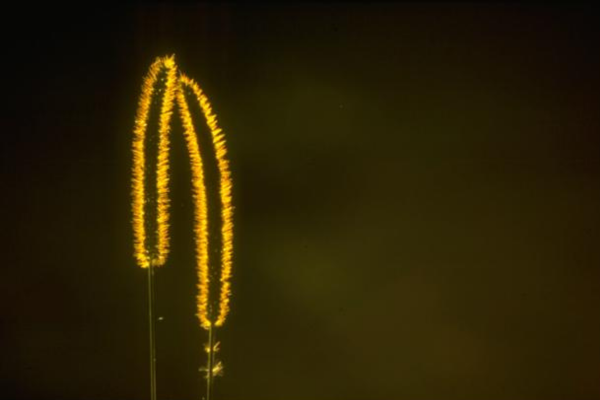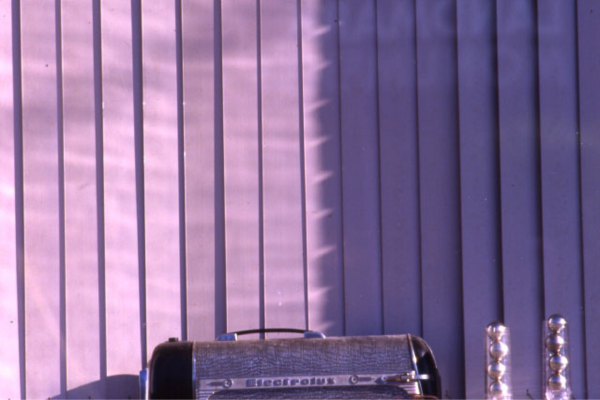Monday
Contemplative Art and Liberation—How it Works Part II
by John McQuade
The great Dharma Master Chögyam Trungpa Rinpoche presented the Buddhadharma and was the progenitor of the Shambhala teachings.
He also was a dharma or contemplative artist in disciplines such as Ikebana, calligraphy, poetry, theatre, photography, “elocution” and so forth. On various occasions he taught the principles and ways of Dharma Art. Some of these teachings are gathered in the book, True Perception.
One of the main points—perhaps the main point—of both the Buddhadharma and Shambhala Dharma ways is liberation: the shift from suffering to ease, self-obsession to compassion, discord to harmony, confusion to Wisdom, setting sun to Great Eastern Sun and so forth.
One might wonder why this great master would bother teaching Dharma Art. Is it an extra or something decisive and helpful as a liberation way? My experience is that these Dharma arts are not only intrinsically liberation ways, but they can act as a catalyst for the Buddhadharma and Shambhala liberation ways. Those ways become more effective, expressive and joyful.
Here is an excerpt of text from Chögyam Trungpa’s Shambhala: Sacred Path of the Warrior from chapter V: Synchronizing Mind and Body. This teaching is presented in three interrelated phases: teachings on synchronization, teachings on direct or true perception and teachings on fearlessness, human dignity and Great Easter Sun vision. This contemplation will focus on the second phase: direct perception.
First there is a little presentation on synchronization. Here the reference is to the synchronization of mind, body and world in contrast to what we often experience as a scattered, awkward and somewhat dysfunctional way with ourselves and the world.
One of the main points is that this capacity for synchronization is not an external imposition but rather a reconnection with our birthright human synchronization: “Synchronizing mind and body is not a concept or a random technique someone thought up for self-improvement. Rather, it is a basic principle of how to be a human being and how to use your sense perceptions, your mind and body together.”
So one of the decisive issues is how to “use your sense perceptions” as a way of synchronization. This is the second phase of the teachings.

“Synchronizing mind and body is also connected with how we synchronize or connect with this world altogether. This has two stages which we call Looking and Seeing…it is somewhat easier to explain the process…in terms of visual perception.”
Then: “Looking is your first projection and if you have doubt…you feel shaky or anxious because you do not trust your vision…but the point is to look properly. See the colors: white, black, blue, yellow, red, green, purple. Look. You cannot not look. There is no other world. This is your world: it is your feast. You inherited these eyeballs; you inherited this world of color. Look at the greatness of the whole thing. Look! Don’t hesitate—Look! Open your eyes. Don’t blink, and look, look—look further.”
So this is how you do it. But how do you do it? This teaching is more of an experience description, a “pointing out” and an invocation. With all due respect it does not provide a practice/experience way.
Miksang contemplative photography provides a practice/experience way (there could be other practice ways as well).
Miksang is a Tibetan word that translates as “Good Eye.” In Shambhala terms it is the “eye or visual” way of Basic Goodness.
Miksang is a Tibetan word that translates as “Good Eye.” In Shambhala terms it is the “eye or visual” way of Basic Goodness.
Miksang asked the question: What is the visual? One could respond that the visual is what we see: what the visual sense registers/presents. What we see is everything that we see. Everything is a big and endless exploration. This is not workable as pedagogy. So we asked does the visual have features, components, elements and so forth. It turns out it does. Everything we see involves color, light, surface (our vision stops at a surface), space and we always see something in particular.

So the first phase—the Looking phase—of the Nalanda Miksang pedagogy and perception/expression training is to work through each of these visual elements. So the first assignment is to explore color as color. Then we explore light and the others.
Now we are embodying, expressing and manifesting Chögyam Trungpa’s teachings. We actually engage Looking as a real register experience. This is a liberation practice and experience. You are there with your direct visual experience. This is a first synchronization contact.
Then there is Seeing.“ You might see something which is the second stage—the more you look the more inquisitive you are, the more you are bound to see—and appreciate the world around you. It is a fantastic new discovery of the world. You would like to explore the entire universe.”
So, after establishing the first visual direct perception contact, the stage of Seeing involves the “inquisitive” “appreciation” and “exploration.” This is where Insight and Liberation ensue.
In Nalanda Miksang there are many contemplative exploration and insight ways. This is the main orientation of Nalanda Miksang. In general, they are presented through another Chögyam Trungpa teaching: Fields of Perception.
Here I am presenting some more basic and fundamental Nalanda Miksang Insight teachings. These are more rooted in the Looking phase of direct perception. The first assignment is “color as color.” Not a colorful thing like a balloon, a flower, or a fire engine. Our slogan is, “fire engine red not a red fire engine.”

This has profound experience, implication and insight registrations. One of the features of this engagement is to discern the difference between the orientation to the “thing world” and the actual experienced appearance/phenomenal world. We actually first see a “fire engine” in terms of its colors, shapes, volumes and so forth. Notions like tires are conceptual additions. For example we cannot see the other side of the fire engine even though we “know it is there.”
This is the thing orientation. This is not exactly mistaken—it is part of our conceptual/pragmatic way of operating in our world. But it is not direct perception. Direct perception is the appearance/phenomenal manifestation. This is what we experience.
More so there is a co-presence of what we experience and the phenomenal manifestation. This is our direct perception contact. As Chögyam Trungpa says:
“There is no other world. This is your world; it is your feast.”
So the features of the appearance phenomenal world are the manifest ways of your experience. The way of appearances is fresh, fluid and free flowing. This means your experience is fresh, fluid and free flowing. This is a first step of contemplative liberation, it is never the “same old, same old.”
This Seeing/insight can run deeper and much deeper. Chögyam Trungpa notes the aspect of “appreciation.” Appreciation means to discern true value. To give a material example: if one wanted to know the value of a piece of jewelry one could go to an appraiser.
Here we are involved with the Wish Fulfilling Jewel: your life. These contemplative art practices are “appreciation ways.” Your life becomes more meaningful in the way that it is always already meaningful. This is everyday liberation.
Then there is the deep liberation insight into the way of reality manifestation. In terms of the Buddha Dharma one would contemplate how the contemplative break from the “thing orientation” to the phenomenal manifestation resonates with a basic teaching such as the Heart Sutra Emptiness/Form.
Here we will stay with this Chögyam Trungpa text. In the Looking section of the text he presents some Insight teachings:
“You inherited this; you inherited these eyeballs: you inherited this world of color.”
Here there is a pointing to the link of the primordial with the phenomenal. We are born with the capacity of vision that opens the visual world. It is a birthright miracle. It does not depend on any conditioned circumstance—other than being born as a human. It does not depend on your gender, your age, your ethnicity, whether you are rich or poor and so forth.
So there is a deep connection between this primordial miracle birthright and each every day, every moment perception way of being in the world. This realized connection is deep liberation.
We have to be kind and reasonable here. This is not a judgment. Our lives are demanding and the “thing world” is a big part of our ongoing orientation. However, it is not our whole world or even our basic experience world. So it is a matter of shifting our allegiance more and more as much as we can and mixing this into the appreciation of our everyday life. This is contemplative liberation. And a special feature of contemplative liberation is that it can be easily integrated with our everyday lives. Indeed, our everyday lives become the way of contemplative liberation.
In the third phase of this text Chögyam Trungpa links this direct perception engagement to the way of everyday warriorship:
“You can see on the spot with wakefulness. Your eyes begin to open…you can see the world is colorful, fresh and free…fantastic…in that way, synchronization of mind and body is also connected with fearlessness…here fearlessness means being able to respond to accurately to the phenomenal world…you begin to realize that you have a perfect right to be in the universe…you have looked and you have seen…this discovery is the first glimpse of what is called the Great Eastern Sun…the dawning or awakening of human dignity—the rising of human warriorship.”
Entries filed under Arts and Poetry
Father Death Blues by Allen Ginsberg – HIGHLIGHT
Allen Ginsberg sings “Father Death Blues,” a poem originally written at his father’s death. Now more than twenty years after Chogyam Trungpa Rinpoche’s passing into parinirvana, it can also be read as a vibrant, truthful, extremely touching and beautiful hommage to Trungpa Rinpoche. This video comes ... continuePosted April 2, 2009 by Jessica Sarapoff
Conversations With My Son
Conversations With My Son By Mushim Ikeda Nash Mushim Ikeda Nash is a writer and Zen practitioner, community peace activist and member of the Buddhist Peace Fellowship, diversity facilitator for Bay Area Buddhist Groups and Naropa University, and mother of a teenage son. In the following essay ... continuePosted March 26, 2009 by
El moco de Clara – HIGHLIGHT
Llegué a Shambhala cerca de doce años atrás, cuando el Centro de Santiago era un departamento pequeño y un poco fantasma y había que “pedir hora” para recibir la instrucción de meditación. Llegué porque no podía dormir; apagaba la luz y mi cabeza no paraba de ... continuePosted March 19, 2009 by
Clara’s Booger
I arrived in Shambhala 12 years ago when the Santiago Shambhala Center was a very small and ghostly apartment and when it was necessary to “ask for a date” in order to receive initial meditation instruction. I wanted the instruction to help me sleep better because ... continuePosted March 19, 2009 by
Dharma Music Blooms in America – HIGHLIGHT
Buddhism has been intertwined with song from its beginnings. Some of the earliest female and male disciples of the Buddha wrote songs and poems about their experiences as new renunciants. As in the Homeric tradition, these songs and poems were sung or recited, memorized and passed ... continuePosted March 7, 2009 by Ravenna
Royal Wedding Celebration in Orissa, India
In the fall of 2006 I found myself talking with Sakyong Mipham Rinpoche about his upcoming wedding in Orissa, India, at the seat of his father-in-law’s lineage in India. The Sakyong asked if I was going; at the time I didn’t think that I would. I asked ... continuePosted February 22, 2009 by Marvin Ross
The Milarepa Children’s Chorus – HIGHLIGHT
Sometime in the mid-1980’s Khenpo Tsultrim Gyamtso Rinpoche was brought to the Kalapa Court in Boulder, Colorado for a brief informal meeting with Chogyam Trungpa Rinpoche. When Khenpo Rinpoche left, Trungpa Rinpoche remarked to his kusung, “A scholar and a yogi!” The Kusung asked, “Is that ... continuePosted February 21, 2009 by
The Five Wisdoms Institute
By Irini Rockwell The Five Wisdoms Institute was founded in 2002 after the publication of my book The Five Wisdom Energies, a Buddhist Way of Understanding Personalities, Emotions and Relationships. continuePosted February 15, 2009 by Irini Rockwell
International Shambhala Arts Day Festival
“A work of art is created because there is basic sacredness, independent of the artist’s particular religious faith or trust. Sacredness from that point of view is the discovery of goodness, which is independent of personal, social, or physical restrictions.” Chogyam Trungpa Rinpoche continuePosted February 14, 2009 by
Shining – Brillance
By/de Nathalie-Pascale Alexandra Boisseau I am told that the magpies like to steal and accumulate shiny and precious objects. This evening in one nest, I found a mirror, And unbearable sadness. Sadness, what are you? As I struggle to console you, to fix you, to understand you, to control you, You ask ... continuePosted February 1, 2009 by nataliepascal-boisseau
![]() RSS feed for the Arts and Poetry category
RSS feed for the Arts and Poetry category
View all posts from authors in Arts and Poetry: Jillian_Johnson

























